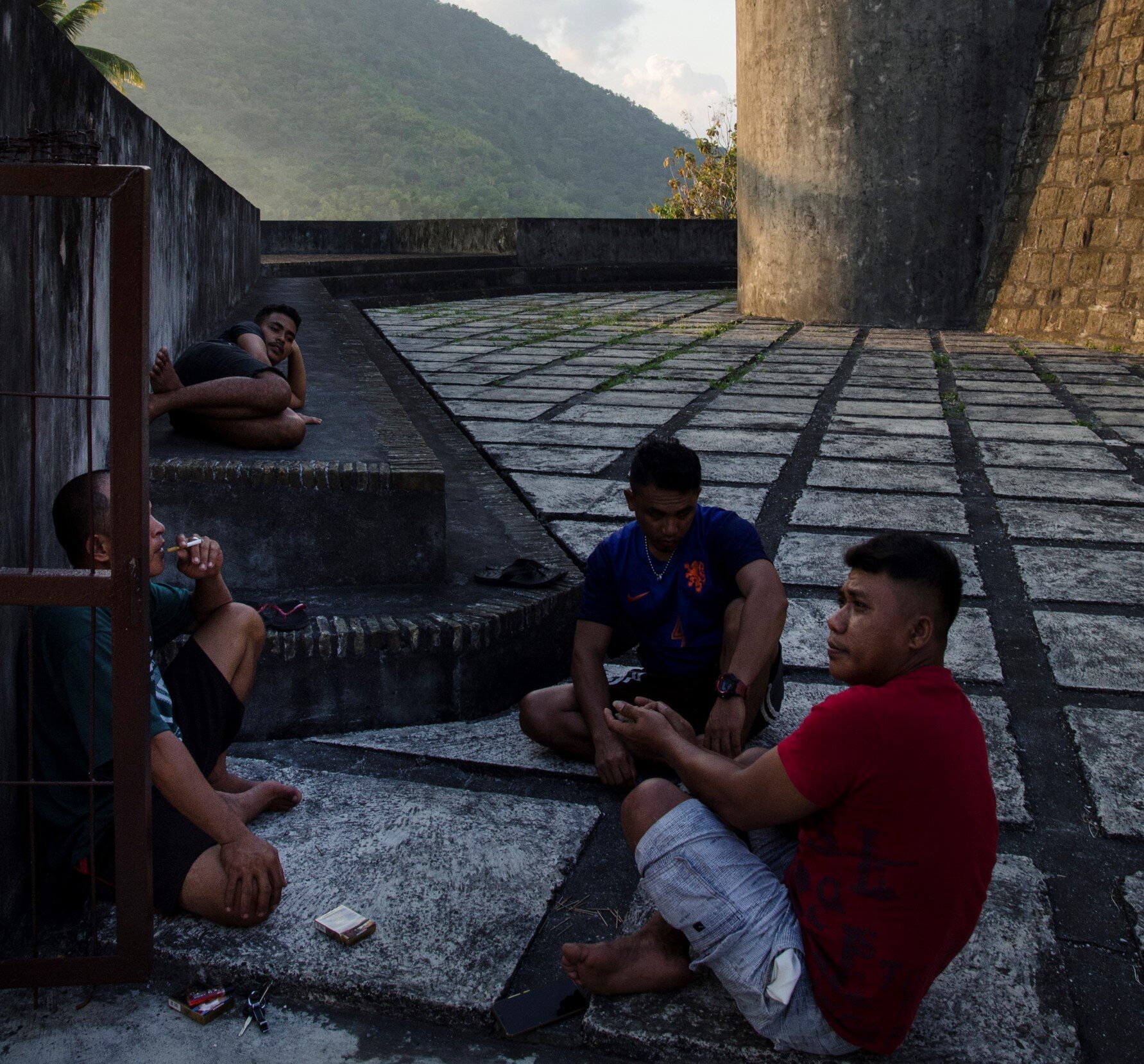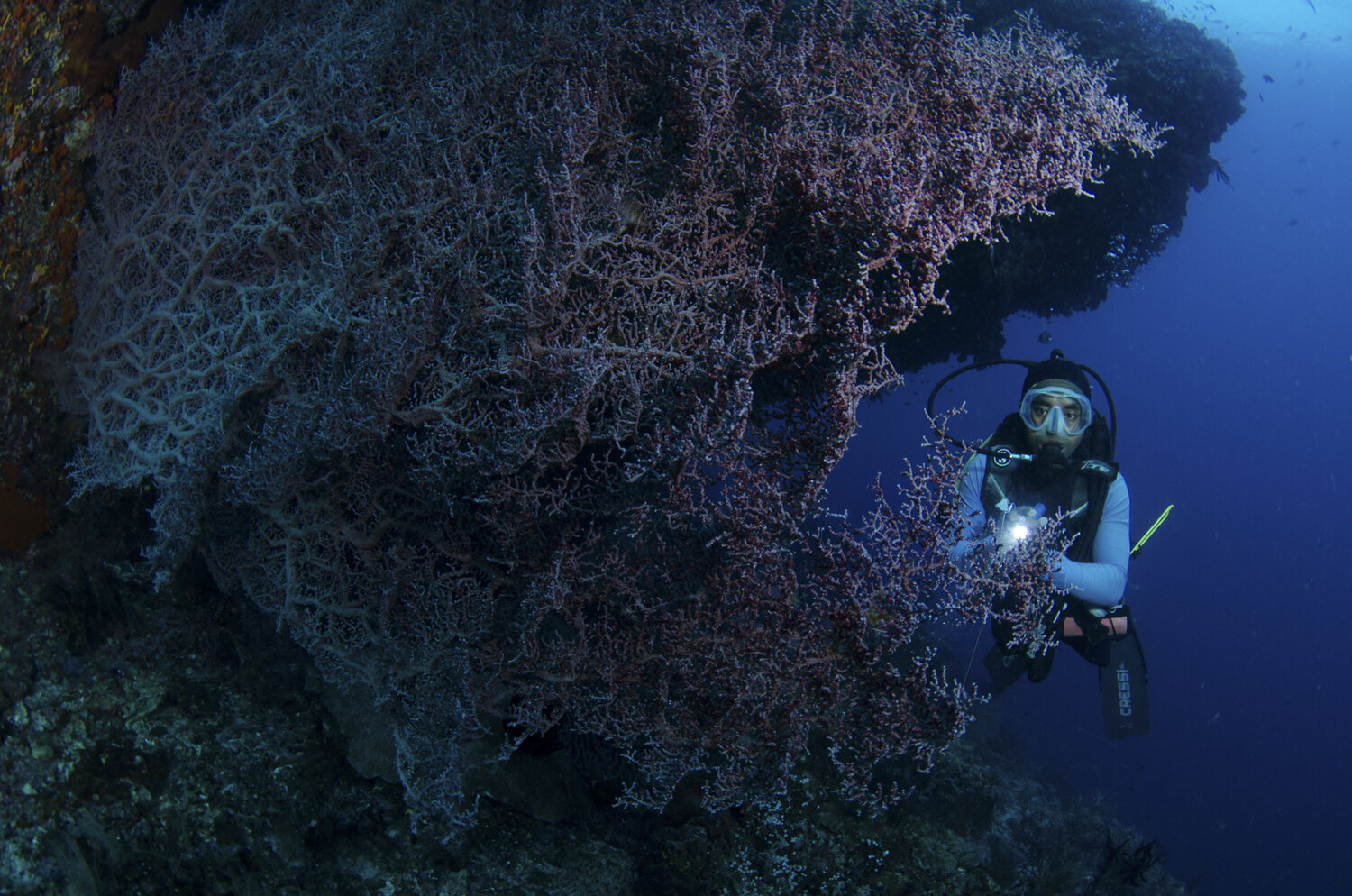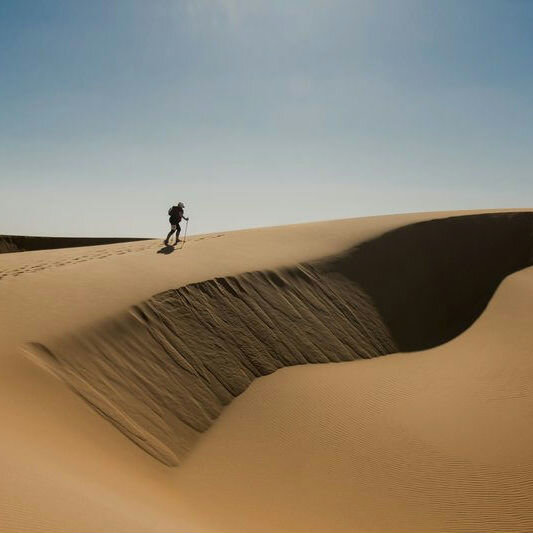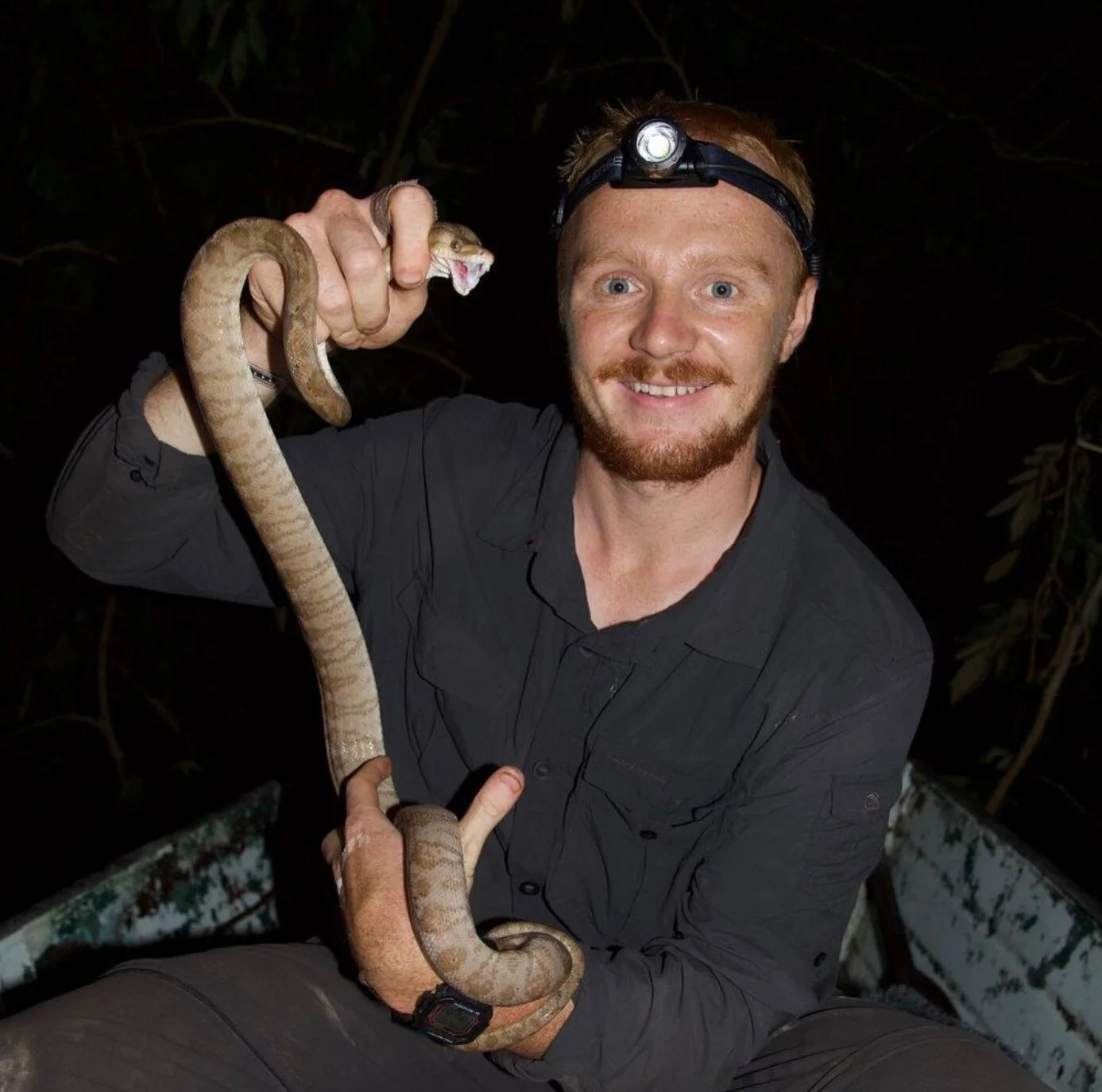A journey into remote island isolation: The Banda Sea, Indonesia

Words and Photography: Will Appleyard
10 min read
The remote Indonesian island of Saumlaki is in the region of 200 nautical miles north of Australia. It took me two days to get there from the UK, each plane getting smaller with each transfer and when my feet finally met the ground for the last touchdown, I never wanted to fasten my seat belt or stow my tray table away ever again.
Saumlaki is west of West Papua and east of Timor-Leste and once the air travel was out of the way, became my embarkation point for the 40-metre live-aboard dive boat “Damai II”. A traditional Phinisi, seven-cabin wooden boat, Damai II was to be home for 12 diving days at sea. We planned only to leave the boat for diving three times a day along with two brief island landings in addition.
Aboard a live-aboard dive boat, except for the diving – our main objective, there is little to do except the obvious functions of necessity, if you choose to do little that is. At sea, sailing between dive sites which can often be 10 or more hours sea time apart, I find myself a quiet spot on deck during the day and read. Within a few hours of joining the boat, I have explored the accessible areas and have tinkered with my diving equipment and cameras until they could be tinkered with no more. The ocean view, although mainly blank, vast and windless, provides a break from my book, as the boat slowly cut through the silky water. The sea initially appears entirely featureless until I really begin to study it for longer. Gazing for enough time, as if looking into a clear night sky looking for shooting stars, dolphins and flying fish begin to appear and from time to time random pieces of flotsam and jettison bobbed past and then birds would arrive, meaning that land is not far away and with it a dive site for us to explore.
I reserve my own cabin space for the evenings, not wishing to waste these sunny days inside while at sea. WIFI is thankfully non-existent unless I want to pay 100 Dollars US per week for satellite WIFI that is, and so with pleasure, I cut myself off from the outside world for my entire time aboard the boat, leaving my phone in a drawer within my cabin.
In the mornings, and evenings, when the light was at its sweet point, I fly my drone from the boat and far out into the distance in order to leave the confines of our wonderful wooden boat and to gain a new perspective of our remote location at sea. I enjoy this feeling of total insignificance exploring our planet covered with no fewer than 7/10ths with water as I would be lost somewhere within the mountains.
Diving begins early each morning on a live aboard dive boat, usually at 07:00 after a thorough dive briefing. Leaving the boat before breakfast for the first of three planned daily dives is my favourite time of day during this Banda Sea exploration. I look forward to a different view of the world and within an environment that as mere humans, we haven’t been designed to visit without our cumbersome equipment.
Free from the confines of the boat, I am able to roam within the ocean around fabulously exotic sounding islands; The Forgotten Island, Manuk Island – aka “The Island of Snakes” and The Banda Islands - perhaps more widely known as The Spice Islands. The Spice Islands are famed for their harvests of nutmeg and cinnamon and the bloodshed distributed by those seeking to monopolise on these product’s global trade. After a bidding war between the British, Dutch, Spanish and Portuguese, the Dutch East India Company finally gained control of trade for these prized spices in 1663, commanding such high prices for the product, it is said that Nutmeg at least, for a time became pound for pound more valuable than gold.
At the water’s surface, I fit my mask and put the regulator into my mouth. Releasing the air from my buoyancy jacket, I slowly sink downwards, leaving the confines of one world to enter another as the water closes around me. This world not only looks and feels different, but sounds different too. Once I am totally immersed in the sea, I adjust my breathing to a deeper, more rhythmic tempo – this feeling is beyond liberating, free-falling through deep, clear blue water until the reef comes into view at the bottom.
A coral reef has a particular sound, the reef creeks and crackles and with continuous echoing, eerily from all around – perhaps from the deep. Occasionally it is possible to hear a chirping noise underwater too, this comes from the damselfish when in close proximity to it. This is a small grey inquisitive fish species that will suddenly appear right in front of my mask or camera lens, perhaps more curious of its own reflection than of me the diver. The reef is a busy place with every few metres almost repetition in animal behaviour of what I have just finned passed. Cleaner wrasse form established stations known to many other fish species that stop by to be picked clean before moving on to other business. Everything else living appears to be either late for something, hiding, feeding or patrolling. Hunters swim back and forth the periphery, in the blue, occasionally dipping into the reef to pick off a moving meal.
We divers are only brief visitors in this world, constrained by the limitations of our air supply and we are wholly aware that spending too much time at depth will saturate our body tissue with nitrogen. This we then have to slowly release by ascending steadily at the end of the dive. We can, for just an hour or so be a part of an environment that we still know very little about, among creatures which either stay out of our way, come over for a closer look or simply go about their business as usual ignoring us completely.
We see very few other dive boats exploring these remote, isolated Banda Sea island archipelagos. Diving at sites named “Too Many Fish” and “Manta Point” deliver BBC Blue Planet-esque scenes underwater. Scenes of pristine reefs, schooling hammerhead sharks, tornados of barracuda and pairs of giant, diver dwarfing oceanic manta rays dancing in pairs above a sea mount cleaning station. Hundreds of spadefish form a wall living underwater wallpaper the background in the distance and occasionally, giant shoals of jacks appear from the deep, breaking their form like a barrelling wave against a beach as they meet the reef’s wall and briefly disperse before reforming into a protective group.
The sulfur spewing Manuk Island or “The Island of Snakes” is about as wild as an island can get, the topography is steep, steaming and dripping with greenery. No people live here. The island is occupied by frigate birds in the air and the trees and then below, where the water line begins, a lot of snakes. These are mostly olive sea snakes at Manuk Island and they’re as happy underwater as they are on land. When in the water the snakes almost rain upon us divers. They’re inquisitive of us too and swim over for a closer look once we have descended into their underwater world. The snakes are present everywhere - from the surface where they breathe, down to around 50 metres deep and on a single breath; they are the ultimate free divers. The snakes have also formed a symbiotic relationship with the trevally fish species and we often see this unlikely pair hunting together on a Jurassic looking black sand volcanic reef. Everything is feeding underwater beside this island, from those critters living within the coral to those just above and mid-water. Barracuda above, perhaps 1000 or more block out the sun for a moment like a living cloud of building weather. I see no evidence of human interference at Manuk Island, not down on the reef or on the water’s surface in any event. We don’t step foot on the island at all, leaving it isolated, wild and undisturbed, as it has been since it emerged from the sea in some unfathomable distant past. For me, this place is as close as one can be to time travel.
Reaching the island Banda Niera some days later, we finally leave the confines of the boat to explore. Diving doesn’t provide much in the way of cardiovascular exercise, in fact quite the opposite. To be back on land for an hour or two, is a novelty and it always takes a few minutes to find our land legs once again.
The air tastes acrid and burns the back of my throat. With no land management systems in place, most of the people here burn their household waste - whatever it’s made from. The old Dutch fort we explore was built in the 1600’s in order to protect the monopolisation of the nutmeg and cinnamon trade. It is a 15-minute hike up through narrow streets and paths and through a village that spills over the hillside. People with kind faces, warm welcomes and curiosity sit outside their houses or buzz past on low powered spluttering motorcycles. There is a small museum on the island run by locals, that houses a collection of artefacts from the Dutch occupation and paintings depicting their apparent lust for killing in order to enforce some kind of control. The fort is empty and we have it to ourselves, save for a small group of girls that we believe have just stepped off an island ferry and a group of local lads playing cards by the fort’s entrance.
Having explored reefs, remote atolls and seamounts far from human inhabitants, we eventually arrive at dawn within the strictly protected marine reserve beside the island of Misool; once a hot spot for the shark fin trade and dynamite fishing. Here we meet other dive boats, now within vicinity of the Raja Ampat archipelago, an increasingly popular destination for underwater explorers visiting from all over the world. In the shallows, juvenile reef sharks enjoy their nursery, without the threat of capture. Tall limestone peaks rise out from rich forests that finish at untouched white sand beaches and the dawn chorus of birds seems to last until dusk.
Here, a booking system is in place for diving and each evening at around 17:00, our boat’s radio bursts into life with neighbouring dive boat operators seeking to secure their dive site bookings for the following day. Here, in order to control the impact that diving may have on the reef system, a “one dive boat per dive site” policy is enforced. And as divers, our policy is to “take only pictures and leave only bubbles”. Nothing is to be touched.
Giant oceanic manta rays patrol the seamounts here. Gliding in twos or threes over a head of rock that lunges skywards from the deep, yet not meeting the surface. These are cleaning stations for the animals, a place where smaller fish species also occupy, picking the rays clean of parasites and dead skin. We spend whole dives observing these rays, each one of them uniquely identifiable from their individual markings. Their wing span is enormous, dwarfing the diver as it flies past for a closer look and clearly enjoying the sensation of our exhaled bubbles on their skin. We continually monitor our dive computers and air supplies, conscious that we can only remain at this depth (25 metres) for around an hour. Depth and time means nothing to the manta ray of course.
Looking away from the reef and into the blue, much of the action underwater can be happening here too. Diver engulfing shoals of anchovy move about the water column in great fluid shapes, as if a murmuration of starlings over Brighton pier. Mobula rays flay past with great agility and speed, in formations of threes or fours, diving through the shoal to feed. Angry looking giant trevally, the size of dustbin lids join in the feast, their armour-plated bodies flashing as they meet with the sun’s rays from above while they snatch fish from the jittery shoal.
I have spent over one thousand hours underwater over the past 16 years, visiting all kinds of locations from Mexican caves, Icelandic fissures, Baltic sea shipwrecks, Thai islands, The Red Sea and the wartime wrecks of the UK. Yet, if was to place my finger on a map and show you where bio-diversity is actually increasing, rather than declining, then it is among these remote islands and protected areas of conservation, deep within Indonesia. This, is what the ocean did, should and would look like.
“We are alone”
© Will Appleyard. No photographs or work should be used without permission.




















